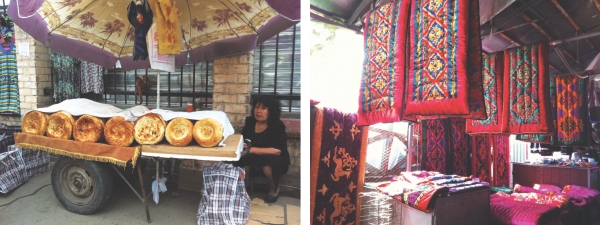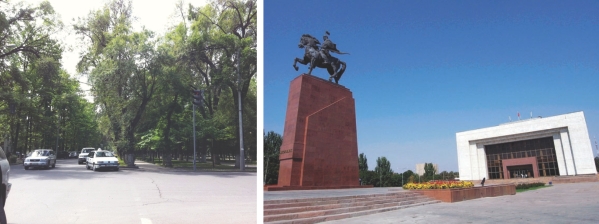| Home - Back Issues - The Team - Contact Us |
 |
| Volume 11 |Issue 34| August 31, 2012 | |
|
|
A Roman Column A Central Asian Journey Bishkek Neeman Sobhan
(This May, I had the opportunity to travel with my husband to Uzbekistan to see the fabled cities of Samarkand and Bokhara. Our journey took us through the capital Tashkent, preceded by a week in Bishkek, the capital of Kyrgyzstan. This is the first chapter of my travel notebook, starting at the point where our journey began.) Our Turkish Airline flight from Rome lands at Manas International Airport in Bishkek in the deadest hour of the night, past one o'clock. As I wait in the tiny lounge and my husband stands at the visa-on-arrival counter, I wonder about Manas, which sounds like Sanskrit for man. I later learn that for the Kyrgyz people, he is that and more. Manas is superman: their epic national hero. (A non-heroic aside: In 2002, the United States used Manas International Airport as an airbase for its military operations in Afghanistan and Iraq.) The airport is 25 kilometres from town, and the official driver, a taciturn Russian called Sasha, drives us in non-English speaking silence through the smooth highway, where huge road signs indicate routes to Dushanbe and Almaty, present and former capitals of neighbouring Tajikistan and Kazakhstan, respectively. Miles of undulating steppes extend to the north into Kazakhstan, but at this hour we cannot see this.
By the time we roll into the empty streets of Bishkek, the lifting darkness of night has diluted into dawn. I hear birds in the trees, and there seems to be lots of trees lining the streets and casting shadows on the buildings that we pass. Presently we enter a gate and roll into an inner courtyard with shabby apartment blocks surrounding it. The stairs are dilapidated but when we enter the service-apartment we are renting for the week, it is surprisingly modern and elegantly furnished. The next day, I accompany my husband to the office a few blocks away, housed in another courtyard ringed with the familiar looking concrete apartment blocks. An empty side room of the office becomes my work zone for the duration of our trip. It is perfect for me: a narrow but airy, well-lit space with a desk near a French window opening onto a ledge-width balcony overlooking a public park. Beautiful Mongol featured, fashionably dressed women and girls walk by. I make a trip to the supermarket downstairs to buy tea bags and crackers and observe the people firsthand. There is freshness and innocence in them, a lack of brash worldliness. There is instead, a palpable energy and pride, natural in a population ready to carve a place for themselves out of the decrepitude and staleness of a past dominated by the Soviet world. Bishkek is a city of wide boulevards, and the shady green parks with flower beds, benches and playgrounds that run for miles through the middle of the avenues give this city a restful and elegant air. It is active but not hectic. The tree-lined streets are laid out tidily on a grid pattern. But many of the sidewalks and by-streets are in dire need of repairs. I know this, because in the days that follow we walk more than we use the car. After hours, we walk to restaurants near the office for dinner, then walk home. So I also eat guilt-free. Ordering from a Russian menu is not easy so, at first, we stick to familiar eateries which have menus in English. Later, with our Kyrgyz coordinator, guide and friend, a charming, modern Muslim woman called Rahat (spelt Rakhat in English and Paxat in Cyrillic) we try some of their national food and also go to Turkish restaurants.
The most popular dishes are Laghman (thick noodles in a broth of vegetables and meat); Ploff, rice with slivered carrots, onions and pieces of fatty lamb or beef. Local cuisine, influenced by a nomadic past, involves the use of sheep fat, mutton, horse meat, fermented mare's milk and such, so I nibble a bit warily through the local cuisine. However, the breads are not only tasty but picturesque. Originally, Bishkek was a caravan rest stop on a branch of the Silk Road that went through the Tian Shan range. This was later fortified by an Uzbek Khan with a mud fort. In 1862, the fort was razed by Tsarist Russians, rebuilding it into a garrison town, which became “Pishpek”, a settlement of Russian peasants, encouraged by the Russian government to set up homes on donated farms. Kyrgyzstan achieved independence in 1991 during the break-up of the Soviet Union. Before independence, ethnic Russians made up the majority of the population of Bishkek. During my visit, I guess they are less than 8 percent of the city's population. But Bishkek still preserves its Russian air with its Soviet-period buildings, gardens and monuments. The main language of communication is still Russian. Today, Bishkek is one of the major cities of central Asia, with many cafes, restaurants, and modern shopping centres. But with Rahat, we visit popular old - fashioned markets, Osh Bazar and Dordoy Bazar. The maze - like alleys are crowded with stalls of both modern goods and of crafts hinting at the people's traditional and nomadic roots; but we dip into the Kyrgyz recent past and buy tall Russian wool caps adorned with the defunct Soviet star. We also see the main sights and monuments of the capital and walk around Ala-Too square, which is a humbler version of Moscow's Kremlin Square. On our last evening, we go to the Opera and Ballet Theatre on 167, Abdyrahmanova Street to see a performance by the St.Petersburg School of Ballet. It is Giselle, the tragic ballet that I have seen before and disliked because it ruined my eye-makeup, which ran down my cheeks in black tears when, spoiler or not, the pale heroine dies right at the start! I had vowed never to see it again. But we all know about 'Never say Never!' So we pay up the 300 soms to enter the grand theatre, just to mess up my mascara, I think ruefully. But between the tall blond Russian primadonna and the short, lithe Kyrgyz male lead dancer, I have to admit, the superb ballet manages to make even the underworld enchanting and render our trip to Bishkek memorable. |
||||||||||||
|
|||||||||||||


